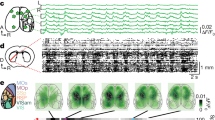Summary
The behavioral relationships of 396 striatum neurons with regular, tonically elevated discharge rates were studied. While monkeys performed a delayed gonogo task, neurons predominantly located in medial putamen responded with phasic depressions (n = 30) or activations (n = 5) to task-specific stimuli. Particularly effective was an instruction light preparing for movement or no-movement reactions, and an auditory signal associated with reward delivery. Stimuli triggering arm or mouth movements were less effective. The data demonstrate that these usually poorly modulated neurons display context-dependent phasic activity in specific behavioral situations.
Similar content being viewed by others
References
Alexander GE (1987) Selective neuronal discharge in monkey putamen reflects intended direction of planned limb movements. Exp Brain Res 67:623–634
Apicella P, Ljungberg T, Schultz W (1989) Reward-related activity of striatal neurons in monkey performing a go-nogo task. Abstr Int. Basal Ganglia Society Meeting, p 8
Crutcher MD, DeLong MR (1984) Single cell studies of the primate putamen. II. Relations to direction of movement and pattern of muscular activity. Exp Brain Res 53:244–258
Hikosaka O, Sakamoto M, Usui S (1989a) Functional properties of monkey caudate neurons. I. Activities related to saccadic eye movements. J Neurophysiol 61:780–798
Hikosaka O, Sakamoto M, Usui S (1989b) Functional properties of monkey caudate neurons. III. Activities related to expectation of target and reward. J Neurophysiol 61:814–832
Kimura M (1986) The role of primate putamen neurons in the association of sensory stimuli with movement. Neurosci Res 3:436–443
Kimura M, Rajkowski J, Evarts E (1984) Tonically discharging putamen neurons exhibit set-dependent responses. Proc Natl Acad Sci 81:4998–5001
Kimura M, Kato M, Shimazaki H (1990) Physiological properties of projection neurons in the monkey striatum to the globus pallidus. Exp Brain Res 82:672–676
Künzle H (1975) Bilateral projections from precentral motor cortex to the putamen and other parts of the basal ganglia: an autoradiographic study in Macaca fascicularis. Brain Res 88:195–209
Liles SL (1985) Activity of neurons in putamen during active and passive movements of the wrist. J Neurophysiol 53:217–236
Rolls ET, Thorpe SJ, Maddison SP (1983) Responses of striatal neurons in the behaving monkey. 1. Head of the caudate nucleus. Behav Brain Res 7:179–210
Schultz W (1986) Responses of midbrain dopamine neurons to behavioral trigger stimuli in the monkey. J Neurophysiol 56:1439–1462
Schultz W, Romo R (1988) Neuronal activity in the monkey striatum during the initiation of movements. Exp Brain Res 71:431–436
Author information
Authors and Affiliations
Rights and permissions
About this article
Cite this article
Apicella, P., Scarnati, E. & Schultz, W. Tonically discharging neurons of monkey striatum respond to preparatory and rewarding stimuli. Exp Brain Res 84, 672–675 (1991). https://doi.org/10.1007/BF00230981
Received:
Accepted:
Issue Date:
DOI: https://doi.org/10.1007/BF00230981




